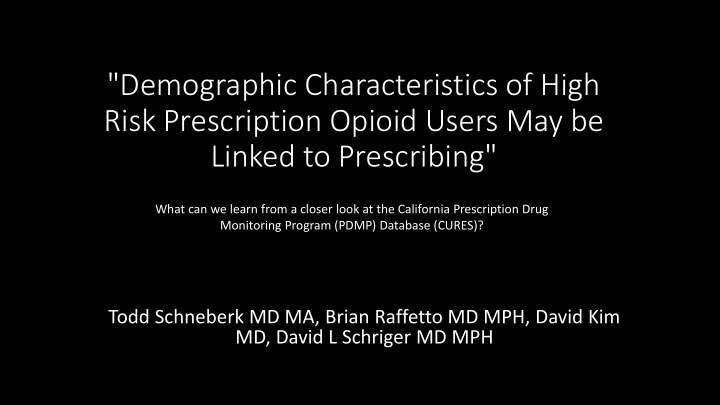

"Demographic Characteristics of High Risk Prescription Opioid Users May be Linked to Prescribing" What can we learn from a closer look at the California Prescription Drug Monitoring Program (PDMP) Database (CURES)? Todd Schneberk MD MA, Brian Raffetto MD MPH, David Kim MD, David L Schriger MD MPH
Disclosures • None
Methods • Prescription Drug Monitoring Program (PDMP) Controlled Substance Utilization Review and Evaluation System (CURES) database 2008- 2015 • 193 million opioid prescriptions • 30 million individual patients • Prescriber, patient and pharmacy identifiers • National Drug Classification Crosswalk to convert drugs to Morphine Milligram Equivalents (MME) • Combined with zip code data from American Community Survey Census Data 2010
Who is at high risk? • High risk use by Chronic High Daily MME • > 20 MME consumed daily for a minimum of 90 days
Inverse Relationship of Poverty and Opioids
Are they doctor shopping? • High risk use by Doctor Shopping • > 5 prescribers or 5 pharmacies within 6 months of use in the database
CHRONIC DOCTOR SHOPPERS HIGH MME
Doctor Shoppers Chronic High (N=42,472) MME * Users (N=306,484) * >20 MME/day for > 90 days) All * Persons >= 1 Opioid Script (N ≈ 3,000,000) *10% of all persons receiving script 2008-15
If we take providers who prescribe: • short acting opioids on > 95% of all of their scripts, • <= 31 pills on 95% of all scripts • only 1 script in the database for >90% of all patients to whom they gave opioids • less than 6 scripts in the database to >99% of patients given opioids • < 540 scripts per year
Limitations • Retrospective Cross-Sectional Dataset Analysis • CURES database did not include majority of demographic data • Zip Code ecological data • Minimal covariates
Conclusions
Recommend
More recommend